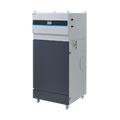Choosing a dust collector
Those requesting for model selection via the Web

By entering the detailed information for the model selection, the calculations will be carried out automatically to select a model that matches the site.
Those who are considering product introduction
![]()
Please feel free to contact us for inquiries such as on-site confirmation of product introduction, product details and prices.
Choosing a dust collector
Select the model of the dust collector based on the required air flow. Check the required air flow in the following order.
Checking the type of dust and generating source
Check the type of dust (to see if it can be sucked in by the GDE series) and the source of the dust.
Determining the type of hood and installation method
Take workability into consideration and examine the type of hood to use and how it is going to be installed. Ensure that dust can be collected at a distance X [m] as close as possible to the source of the dust.
Check the control air speed
The control wind speed to derive the performance of the local exhaust equipment according to the model of the hood is stipulated in the Ordinance on Prevention of Hazards Due to Dust.
Control wind speed stated in the dust impairment prevention regulations (Ordinance on Prevention of Hazards Due to Dust)
Control air speed according to the provisions in the standards under Article 27 Para 1 of the Ordinance on Prevention of Hazards Due to Dust
| Model of hood | Control air speed (m/s) | |
|---|---|---|
| Enclosure-type hood | 0.7 | |
| Externally-mounted hood | lateral suction type | 1.0 |
| Bottom suction model | 1.0 | |
| Upper suction model | 1.2 | |
Remark
|
||
Control wind speed of a machine having a rotating body like a grinding machine or drum sander etc. pursuant to the provisions in Article 4 or Article 27 Paragraph 1 of the Ordinance on Prevention of Hazards Due to Dust
| How to install the hood | Control air speed (m/s) |
|---|---|
| How to enclose an entire machine having rotating bodies | 0.5 |
| In this method, the dispersion direction of the dust generated by the rotation of the rotating body is covered at the opening side of the hood | 5.0 |
| How to enclose only the rotating bodies | 5.0 |
Remark
|
|
Calculating the required air flow
The required air flow is calculated from the type and shape of the hood and the control wind speed was determined in the preceding paragraph.
| Model of hood | Sketch | Airflow Q(m3/min) |
|---|---|---|
| Enclosure-type |  |
Q=60·A·Vo =60·A·Vc Vo:Average wind speed at the opening face[m/s] |
| External type (Rectangular or circular canopy hood) |
 |
Q=60·VC·(10X²+A) |
| External type (Circular or rectangular hood with flange provided in free space) |
 |
Q=60·0.75·VC·(10X²+A) |
| External type (Circular or rectangular hood provided in free space) |
 |
Q=60·1.4·P·H·Vc |
We're here to give you quick answers to your questions.
